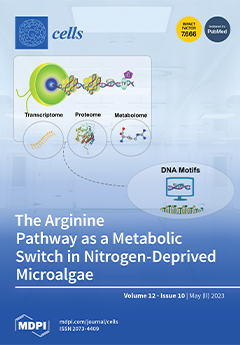Background: Survivin is an inhibitor of apoptosis protein (IAP), encoded by the Baculoviral IAP Repeat Containing 5 (
BIRC5) gene located on q arm (25.3) on chromosome 17. It is expressed in various human cancers and involved in tumor resistance to radiation
[...] Read more.
Background: Survivin is an inhibitor of apoptosis protein (IAP), encoded by the Baculoviral IAP Repeat Containing 5 (
BIRC5) gene located on q arm (25.3) on chromosome 17. It is expressed in various human cancers and involved in tumor resistance to radiation and chemotherapy. The genetic analysis of the
BIRC5 gene and its protein survivin levels in buccal tissue related to oral squamous cell carcinoma (OSCC) in South Indian tobacco chewers has not been studied. Hence, the study was designed to quantify survivin in buccal tissue and its association with pretreatment hematological parameters and to analyze the
BIRC5 gene sequence. Method: In a single centric case control study, buccal tissue survivin levels were measured by ELISA. A total of 189 study subjects were categorized into Group 1 (n = 63) habitual tobacco chewers with OSCC, Group 2 (n = 63) habitual tobacco chewers without OSCC, and Group 3 (n = 63) healthy subjects as control. Retrospective hematological data were collected from Group 1 subjects and statistically analyzed. The
BIRC5 gene was sequenced and data were analyzed using a bioinformatics tool. Results: Survivin protein mean ± SD in Group 1 was (1670.9 ± 796.21 pg/mL), in Group 2 it was (1096.02 ± 346.17 pg/mL), and in Group 3 it was (397.5 ± 96.1 pg/mL) with significance (
p < 0.001). Survivin levels showed significance with cut-off levels of absolute monocyte count (AMC), neutrophil/lymphocyte ratio (NLR), and lymphocyte/monocyte ratio (LMR) at (
p = 0.001). The unique variants found only in OSCC patients were T → G in the promoter region, G → C in exon 3, C → A, A → G, G → T, T → G, A → C, G → A in exon 4, C → A, G → T, G → C in the exon 5 region. Conclusions: The tissue survivin level increased in OSCC patients compared to controls; pretreatment AMC, LMR, and NLR may serve as add-on markers along with survivin to measure the progression of OSCC. Unique mutations in the promoter and exons 3–5 were observed in sequence analysis and were associated with survivin concentrations.
Full article






